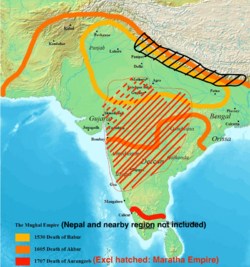Mughal period
| Mughal Empire | ||||||||||||||||||||
|
گورکانیان (Persian) Gūrkāniyān مغلیہ سلطنت (Urdu) Mug̱liyah Salṭanat |
||||||||||||||||||||
|
||||||||||||||||||||
|
The Mughal Empire at its greatest extent, in 1707
|
||||||||||||||||||||
| Capital |
|
|||||||||||||||||||
| Languages |
|
|||||||||||||||||||
| Religion |
|
|||||||||||||||||||
| Government | Absolute monarchy, unitary state with federal structure | |||||||||||||||||||
| Emperor | ||||||||||||||||||||
| • | 1526–1530 | Babur (first) | ||||||||||||||||||
| • | 1837–1857 | Bahadur Shah II (last) | ||||||||||||||||||
| Historical era | Early modern | |||||||||||||||||||
| • | First Battle of Panipat | 21 April 1526 | ||||||||||||||||||
| • | Empire interrupted by Sur Empire | 1540–1555 | ||||||||||||||||||
| • | Death of Aurangzeb | 3 March 1707 | ||||||||||||||||||
| • | Siege of Delhi | 21 September 1857 | ||||||||||||||||||
| Area | ||||||||||||||||||||
| • | 1690 | 4,000,000 km² (1,544,409 sq mi) | ||||||||||||||||||
| Population | ||||||||||||||||||||
| • | 1650 est. | 145,000,000 | ||||||||||||||||||
| Currency | Rupee | |||||||||||||||||||
|
||||||||||||||||||||
| Today part of | ||||||||||||||||||||
The Mughal Empire (Urdu: مغلیہ سلطنت, translit. Mughliyah Salṭanat) or Mogul Empire, self-designated as Gurkani (Persian: گورکانیان, Gūrkāniyān, meaning "son-in-law"), was an empire in the Indian subcontinent, established and ruled by a Muslim dynasty of Chagatai Turco-Mongol origin from Central Asia. The dynasty, though ethnically Turco-Mongol, was Persianate in terms of culture.
The Mughal empire extended over large parts of the Indian subcontinent and Afghanistan. The empire at its peak, was the second largest to have existed in the Indian subcontinent, spanning 4 million square kilometres at its zenith, after the Maurya Empire, which spanned 5 million square kilometres.
The beginning of the empire is conventionally dated to the victory by its founder Babur over Ibrahim Lodi, the last ruler of the Delhi Sultanate, in the First Battle of Panipat (1526). The Mughal emperors were Central Asian Turco-Mongols belonging to the Timurid dynasty, who claimed direct descent from both Genghis Khan (founder of the Mongol Empire, through his son Chagatai Khan) and Timur (Turco-Mongol conqueror who founded the Timurid Empire). During the reign of Humayun, the successor of Babur, the empire was briefly interrupted by the Sur Empire. The "classic period" of the Mughal Empire started in 1556 with the ascension of Akbar the Great to the throne. Under the rule of Akbar and his son Jahangir, the region enjoyed economic progress as well as religious harmony, and the monarchs were interested in local religious and cultural traditions. Akbar was a successful warrior who also forged alliances with several Hindu Rajput kingdoms. Some Rajput kingdoms continued to pose a significant threat to the Mughal dominance of northwestern India, but most of them were subdued by Akbar. All Mughal emperors were Muslims; while Akbar was Muslim most of his life, he propounded a syncretic religion in the latter part of his life called Deen-i-Ilahi, as recorded in historical books like Ain-e-Akbari and Dabestan-e Mazaheb.
...
Wikipedia

